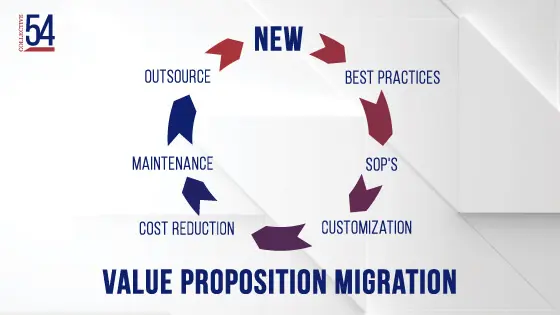The Migrating Value Proposition: How to Recognize It and Get Ahead of Your Competitors

When was the last time you gave some serious thought to your firm’s value proposition? If you don’t know the answer, you’re overdue for a value proposition innovation overhaul.
Why focus on this subject? Simple: Value propositions are dynamic, not static. Over time, all products and solutions commoditize. Accordingly, related value propositions migrate from “new” to “old” — and this means prospects and clients value different attributes of an offer in different ways.
For example, when a new category is created, prospects look first for technology providers and systems integrators. Because the category is new, there is a shortage of those firms. This creates a scarcity effect, making the firms who got into the category early very successful.
However, as time marches forward, more of the expertise possessed by early firms gets embedded into other firms’ best practices and standard operating procedures. As these best practices become widely available, the value proposition migrates. The scarce resource is no longer rare expertise. Rather, it becomes a firm’s ability to customize a best practice for a client’s specific need.
The value proposition that clients respond favorably to at this point is a firm’s customization capability. Later, as the commodification process continues, prospects start looking for cost-reduction enablers, maintenance providers, and ultimately, at the end of the commodification cycle, outsourcers.
Put simply, this is the lifecycle of every value proposition for consulting services.
Recognizing and Leveraging Your Value Proposition
Boutique professional service firms need to care about migrating value propositions if they want to grow and scale their firms as part of their competitive strategies in business.
Why? Imagine a firm still believing they possess rare expertise and charging a premium for it… only to learn of a competitor who can do what they can do for half the price. A firm like that would lose a lot of deals and not grow much.
Alternatively, imagine a client that no longer wants to perform an activity in-house and is looking to outsource. If your firm is trying to convince the client to keep the process in-house and customize it because you do not offer outsourcing, you will not be able to grow.
The bottom line is that your service firm needs to migrate its value proposition at the same time that your prospects migrate their evaluation criteria when selecting a firm to partner with.
There are many examples of professional service categories having been commoditized. Firms in these categories are required to migrate their value propositions:
- In accounting, QuickBooks now sells online accountants for $0-$50/hr.
-
- In law, you can create an LLC for $200 bucks with LegalZoom.
-
- In graphic design, you can get unlimited designs for $499/month from Design Pickle.
-
- In IT, you can get code written for you for $0 via ChatGPT.
I could go on and on. It is not IF your niche will get commoditized; it is when. Get ahead of it. Migrate your value proposition or suffer painful years of flat growth.
How to Acknowledge and Move With a Migrating Value Proposition
So how does a professional service firm like yours that wants to develop a competitive business strategy deal with this? I have three suggestions that will help you sidestep a preventable issue.
First, recognize the trend. Ask yourself, “Are my prospects and clients behaving differently? Have they recently started asking me for different things that might signal a migrating value proposition?” If the answer is “yes,” take note of this as an opportunity for a professional services value proposition change.
Second, anticipate where the migrating category may be headed. Is the category maturing? If so, should you start focusing on being a cost-reduction enablement firm or an outsourcer? Or, if the category is commodifying, how could you reposition your firm into a new growth category that is years away from commodification?
Third, consider what your competitors are doing. Can you beat them by migrating your value proposition before they do? And after you migrate, is there anyone who has already beaten you to the punch?
Members at Collective 54 who have taken these proactive steps have done well. As the market shifted, they were able to shift with it by migrating their value propositions seamlessly. At the same time, they identified undervalued scarce resources and secured them before the market recognized the need for them. For instance, this podcast shows how member Aron Clymer migrated his firm’s value proposition and has seen excellent growth as a result of his efforts.
The last thing any evolving professional services firm wants or needs is to be surprised by a migrating value proposition. Instead of seeing your value proposition as something set in stone, see it as a flexible asset destined to change. That way, you’ll operate more competitively and position your firm to potentially become an early adopter of the next big thing.
